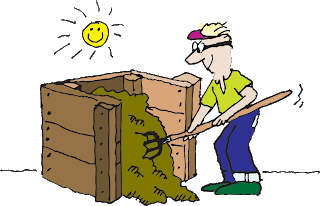●There is always something more you can do to live green.
●It is easier if you make a gradual change into living green.
●Do as much or as little as you want.
●You can even make a change by doing one thing.
Here are the stages I took to living green:
Stage 1:
I made my first changes in college when I learned that I could do more to help this planet.
1. I stopped getting magazine subscriptions.
2. I stopped using trays in the cafeteria.
3. I only washed my clothes when I had a full load. I also started using cold water instead of hot.
4. I bought reusable bags for groceries.
5. I started paying bills online.
Stage 2:
These are changes that I made when I lived in Fort Collins.
1. I started buying used clothes.
2. We started buying in bulk. We put bulk items in old glass jars and containers instead of throwing them away.
3. To keep our apartment cool in the summer we shaded our windows. At night we opened the windows. In winter we kept the blinds open so that the sun could come through.
4. We took our recyclables to the recycling center.
5. I decided to no longer give material gifts to people. I will now only give food, money, gift cards, concert tickets, etc. to people.
6. We became vegan! This certainly helps the environment.
7. We only flush when we poop. We became more conscious of how much toilet paper we were using.
Stage 3:
I made further changes when I moved to Vermont with Kyle.
1. We stopped buying paper towels and napkins.
2. I ride the bus to work and walk to town to go to the library, bank, etc.
3. We stopped using a dishwasher. We have 2 of everything: bowls, plates, utensils, etc. When we finish eating, we clean right away.
4. We started composting!
5. I bring a water bottle to work.
6. We bought seventh generation laundry detergent.
7. I bought glasses and will eventually wear glasses all the time. I am using contacts right now when I teach skiing. Contacts and saline solution are more things that are added to the dump.
8. We stopped using bags at the produce section. (I never thought about this for some reason. I guess I just always watched my mom use bags at the produce section.)
Future goals:
1. Buy reusable bags for bulk.
2. We are provided lunch at work but they use disposable plates, cups, etc. I want to bring my own Tupperware and utensils.
3. Use a moon cup instead of tampons/pads. I already bought one onlineJ
4. Bring our own coffee mugs and Tupperware when we drink and eat out.
5. I want to use oil lamps and candles instead of using electricity.
6. I want to start timing my showers and keep them under 5 minutes.
A little farther down the road:
1. Stop using toilet paper.
2. Use poop as compost. Think about how much water is used so that we can use the bathroom.
3. Grow our own fruits and vegetables.
4. Live off the grid.

















